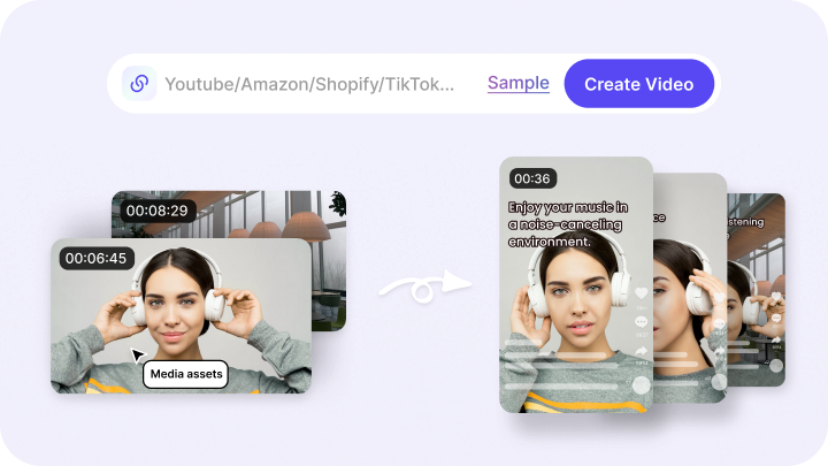How to effectively use video marketing in e-commerce?
Video Marketing

When people shop online, photos alone rarely tell the full story. A short video can show how a product looks, works, and fits into everyday life, turning hesitation into action. For e-commerce brands, this makes video one of the most effective ways to build trust and increase sales.
The real question is how to use video in a way that works. From choosing the right formats to using the right tools and promoting content effectively, having a clear approach matters.
In the following sections, I'll walk through four areas that can help you make video a practical part of your e-commerce strategy:
- Why Video Marketing Matters in E-commerce
- Types of Videos That Drive Sales
- Using Topview to Enhance Video Marketing
- How to Promote Your Videos Effectively
Why Video Marketing Matters in E-commerce
Video makes online shopping feel less distant. Instead of guessing from photos, shoppers get to see how a product works, how it looks in motion, and why it might be worth buying. This small difference often changes the way people decide.
It helps people picture the product in use.
Think of a shopper looking for a backpack. A photo shows the color and design, but a video can reveal how it fits on a person's shoulders, how much it holds, and even how smoothly the zippers open. This simple detail often makes the decision easier.It creates a sense of trust.
When viewers see a real person unboxing an item or walking through its features, the product feels more authentic. A skincare brand, for example, can show how a serum is applied and how the texture looks on the skin. It feels more reliable than polished studio shots alone.It keeps people engaged for longer.
Scrolling through an online store can feel flat, but video naturally catches the eye and holds attention. A short explainer on a product page or a lifestyle clip on social media keeps customers interested and encourages them to spend more time with your brand.
Types of Videos That Drive Sales
Some videos are great for building trust, while others are better at showing details or sparking excitement. Here are a few types that tend to perform best in e-commerce:
Product demos
These videos focus on how the product actually works. For example, a kitchen brand can film someone cooking with a new blender, showing how fast it crushes ice or how easy it is to clean. Customers quickly see the value without reading a long description.Unboxing and customer reviews
Shoppers love hearing from people who already own the product. An unboxing clip or a simple review recorded by a real customer feels personal and trustworthy. This type of video often answers the questions buyers didn't know they had, such as packaging quality or first impressions.Tutorials and how-to content
Teaching sells. A beauty brand might post a quick tutorial on how to create a look using their eye shadow palette, while a tech store might show how to set up a device in less than five minutes. These videos help people feel confident that they will know how to use the product right after buying it.Brand story and lifestyle clips
Sometimes the goal is not to explain a product, but to show what the brand stands for. Short lifestyle videos that place products in everyday settings—like a fitness brand showing off its gear in a morning workout routine—help customers connect emotionally and see themselves in that story.
Each of these formats can support different parts of the buying journey. Demos highlight features, reviews build trust, tutorials reduce friction, and lifestyle clips inspire desire. Mixing them gives shoppers a fuller picture and keeps your content fresh.
Using Topview to Enhance Video Marketing
High-quality videos often take more time and budget than most e-commerce teams can afford. AI tools make this easier by turning simple assets into polished, ready-to-publish content.
Topview is one of the most practical options. It's an AI video creation assistant built for online sellers, designed to turn product images, links, or short clips into engaging ads without the usual production costs.
Here are four features that make Topview especially useful:
1. Avatar 4
With just a photo and a script, Avatar 4 creates a lifelike talking avatar. Lip sync and body movements are synced naturally, and you can even prompt the avatar to perform gestures while speaking. It's perfect for product explainers or spokesperson-style videos.
2. Materials to Video
Upload product images, raw clips, or even a URL, and Topview generates a complete video with script, transitions, subtitles, and voiceover. This saves hours of work and gives you ready-to-publish content for TikTok, Reels, or Shorts.
3. Product Avatar
This feature brings your product into the hands of AI avatars. Whether it's a phone, a bag, or a skincare item, the avatar can display it naturally, making the product feel more tangible to viewers.
4. Product AnyShoot
Think of it as virtual staging. A single product photo can be placed in lifestyle settings—like a kitchen counter, a living room, or an outdoor scene—without a photoshoot. It helps shoppers imagine the product in their own lives.
Getting started with Topview is easy. The interface is designed for marketers, not video editors, so you don't need advanced skills to produce professional content.
How to Promote Your Videos Effectively
Creating a good video is only half the job. The other half is making sure people see it. Here are a few practical ways to get your videos to the right audience:
Add videos directly to product pages
Videos don't just belong on social media. Placing a demo or explainer right on the product page helps shoppers decide faster. Platforms like Shopify and Amazon already support this, and brands that use it often see higher conversion rates.Use short-form social platforms
TikTok, Instagram Reels, and YouTube Shorts are where product discovery often begins. Post your clips natively on these platforms and use trending sounds, captions, or hashtags to improve reach. The key is to keep videos short, clear, and easy to watch.Repurpose for ads
Your best-performing videos can also run as paid ads. A quick lifestyle clip or testimonial often works better than polished commercials because it feels natural. Test different variations such as 15 seconds vs. 30 seconds, different hooks, or different CTAs to see what resonates.Include video in email and remarketing campaigns
Adding a short video thumbnail to your email newsletters can boost click-through rates. For remarketing, serve product videos to people who have already visited your site but haven't purchased it. Seeing the product in action might be enough to bring them back.
Conclusion
Video has become one of the most effective ways to sell online because it builds trust and shows products in action. By choosing the right formats, using tools like Topview to simplify production, and promoting content across the right channels, e-commerce brands can turn videos into a steady driver of sales.

